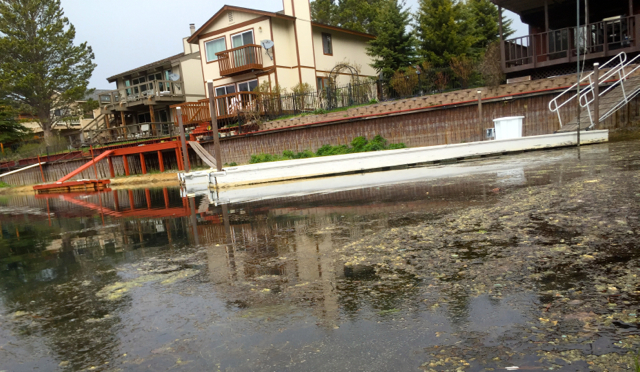Tahoe Keys struggles to manage invasive weeds

Milfoil was first discovered in the Tahoe Keys in the 1980s and curlyleaf pondweed in 2003. Photo/LTN
By Kathryn Reed
STATELINE – In less than a year, the Tahoe Keys Property Owners Association has started to backpedal when it comes to being adamant herbicides are the only way to rid the South Lake Tahoe canals of invasive weeds.
At the Tahoe Regional Planning Agency Governing Board meeting this week representatives of the housing development shared that field demonstrations will be conducted this summer with the goal of having a long-term solution in place for 2017. The TKPOA board two weeks ago allocated $250,000 for this summer’s work.
The Keys is the No. 1 source for invasive weeds, with Eurasian milfoil, curlyleaf pondweed and coontail being the most predominant. The weeds affect 90 percent of the lagoons.
At a meeting last August the solution was herbicides.
What has slowed down that potential reality is the number of comments to the draft Integrated Management Plan for Aquatic Invasive Weeds. Many people want other alternatives to be investigated. And while killing the weeds with ultraviolet light was pooh-poohed by authorities at last summer’s meeting, that is no longer the case.
John J. Paoluccio, president of Inventive Resources Inc., was in town last fall to demonstrate how UV light works. People were impressed. So much so that either the Keys or Lakeside Marina is likely to be a testing ground this year.
The Keys also plans to use herbicides in a test situation in isolated tanks on land. This will show how the plants respond to different chemicals.
Before any herbicide could be used in the lake the Lahontan Regional Water Quality Control Board would need to sign off on it. That board has already said the idea of limited use of herbicides on a case-by-case basis would be taken under consideration.
There are 10-deadend lagoons. Those would likely be the first to receive herbicide.
Dye is going to be put into the mouth of the Keys’ two entrance points to see where the current takes it and how fast. This relates to what would happen if an herbicide were used. Dye was used farther back in the canals last year as a test, with the colored water not moving far.
One Governing Board member asked if native species would be harmed. The answer – they shouldn’t be.
While harvesting the weeds is considered a nuisance in some ways because particles are spread and it never solves the problem, tweaking the process may have different results. A fragment capture boat will be deployed to scoop up the remnants. GPS tracking and paying better attention to the wind are other changes.
A water circulation mechanism was installed when the Keys was built in the late 1960s. It has not been used for a couple decades. TKPOA is going to see what it would take to get it operational again.
Another board member asked about the possibility of closing off the two main channels to be able to isolate the Keys in order to deal with the weed problem. While tidal gates exist, a big problem is there is boat traffic year-round. A bigger problem is that the three owners involved with the waterways in the Keys are not all on the same page.
TKPOA and Beach and Harbor Association are in agreement about things that need to be done. The owners of the marina are not cooperating, according to TKPOA and TRPA officials. Because the marina has a different type of permit than the homeowners, there is only so much pressure that can be applied.


